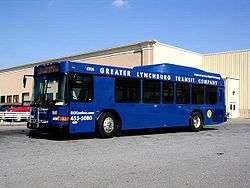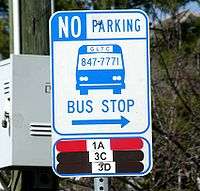Greater Lynchburg Transit Company
The Greater Lynchburg Transit Company is the non-profit, publicly owned company responsible for providing bus service for Lynchburg, Virginia, since its creation in 1974.[3] The GLTC Board of Directors sets and is responsible for both the general policies as well as the selection of the management company responsible for operation the service. The Board is composed of nine-members that are appointed by the Lynchburg City Council.[3] As of 2015, First Transit is responsible for the operation of the network, and their subsidiary, Central Virginia Transit Management Company is oversees the actual employment of the GLTC's bus drivers, mechanics, and other staff.[3]
 | |
 | |
| Founded | 1974 |
|---|---|
| Headquarters | Lynchburg, Virginia |
| Locale | Lynchburg, Virginia |
| Service area | Lynchburg, Virginia & Liberty University |
| Service type | Local & campus shuttle bus service |
| Fleet | 39 (2008)[1] |
| Annual ridership | 2,396,700 (2015)[2] |
| Operator | First Transit |
| Website | http://www.gltconline.com/ |
GLTC serves a population of 80,846 in an area covering 72 square miles (186.5 km2), and in 2006 totaled 1,117,971 unlinked passenger trips.[4]
Bus fleet
- 3 Gillig Diesel/Electric Hybrid, 40 feet (12 m) low floor buses[1]
- 14 Gillig Diesel/Electric Hybrid, 35 feet (11 m) low floor buses[1]
- 7 Gillig Diesel/Electric Hybrid, 29 feet (8.8 m) low floor buses[1]
- 10 Gillig Diesel, 35 feet (11 m) low floor buses[1]
- 12 Ford/Supreme, E-450, 22 feet (6.7 m) (in operation for paratransit)[1]
- 1 Chance, VS-24 replica trolley[1]
Routes

Liberty University shuttle service
On November 10, 2006, the GLTC entered an agreement with Liberty University to operate the shuttle bus service on its campus.[5] Service would commence on January 15, 2007, with six buses serving the campus.[6] The service operates from 7 a.m. to midnight Monday through Thursday; from 7 a.m. to 1 a.m. Friday and Saturday; and from 8 a.m. to 10 p.m. Saturday and Sunday. Serving Liberty's main, north and east campuses, the system originally consisted of eight stops.[6] Costing $1,000,000 annually for the service, Liberty students and employees can utilize the shuttle service without paying a fare each time.[5]
By November 2007, the service saw its 1,000,000th passenger, which doubled the average annual ridership for the GLTC as a whole.[7] With ridership for the service growing from 3,900 passengers per day in spring 2007 to 7,400 in fall 2007, university officials are working in conjunction with the GLTC to expand the service to include areas off campus in the area around the university.[7]
See also
References
- Greater Lynchburg Transit Company. "Greater Lynchburg Transit Company: Fleet/Facilities". Retrieved 2008-02-23.
- "Transit Ridership Report Fourth Quarter 2015" (pdf). American Public Transportation Association. March 2, 2016. Retrieved 2016-11-14 – via http://www.apta.com/resources/statistics/Pages/ridershipreport.aspx.
- Greater Lynchburg Transit Company. "Greater Lynchburg Transit Company: Home". Retrieved 2008-02-23.
- Federal Transit Administration. "National Transit Database: Greater Lynchburg Transit Company" (PDF). Archived from the original (PDF) on 2011-07-14. Retrieved 2008-02-23.
- Brown, Ron; Conor Reilly (November 10, 2006). "GLTC, LU ink deal on buses". The Lynchburg News & Advance.
- Brown, Ron (December 9, 2006). "LU, GLTC make deal". The Lynchburg News & Advance.
- Desrets, Christa (November 1, 2007). "GLTC looking to expand service to more areas". The Lynchburg News & Advance.
External links
- Greater Lynchburg Transit Company official website